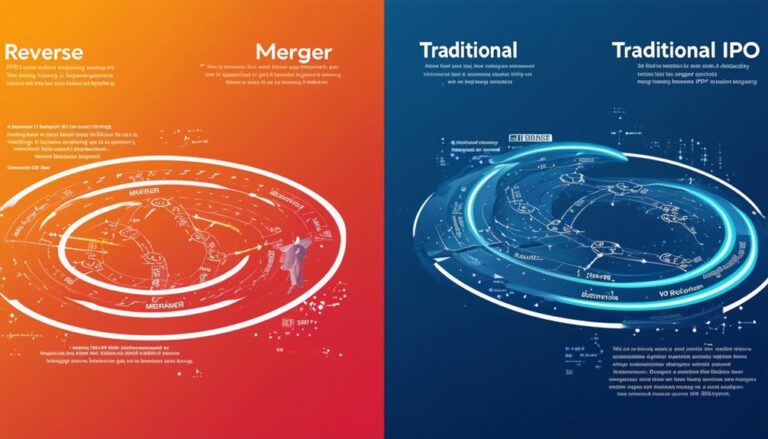Exploring the Financial Reporting Considerations of a Reverse Merger

Understanding the financial reporting complexities of a reverse merger involves a comprehensive understanding of the situation. It is essential to assess the accounting implications, such as fair value adjustments to assets and liabilities, and the resulting impact on financial statements.
Valuation factors, including earnings projections and contingent arrangements, play a crucial role and must be carefully considered. Maintaining governance and regulatory compliance is imperative to ensure financial integrity and transparency throughout the process.
Thorough due diligence is key to identifying potential risks and liabilities associated with the reverse merger transaction. By addressing these critical considerations, organizations can enhance the outcomes of the transaction and position themselves for long-term success.
Further exploration of these details can offer valuable insights into the financial reporting aspects of a reverse merger.
Key Takeaways
Accurate determination of the fair value adjustments to the acquired company's assets and liabilities is crucial for the financial statements of the merged entity. This ensures that the financial position of the newly combined entity is accurately reflected. It is important to consider the specific valuation methods and techniques applicable to the assets and liabilities acquired in a reverse merger to avoid misrepresentation of the financial health of the entity.
Proper disclosure and transparent communication of the financial implications of a reverse merger are vital for ensuring compliance with regulatory requirements. By providing clear and comprehensive information about the financial impact of the merger, stakeholders can make informed decisions and understand the potential risks and benefits associated with the transaction. Transparency is key in maintaining trust and credibility in the financial reporting process.
Earnings projections and arrangements related to contingent considerations can have a significant impact on the valuation and financial reporting of the merged entity. It is essential to carefully evaluate and disclose any potential future payments or adjustments that may affect the financial performance of the entity. By accurately reflecting these projections and arrangements in the financial statements, the merged entity can provide a more realistic picture of its financial position.
In the process of financial reporting for a reverse merger, it is important to diligently recognize noncontrolling interests and historical equity adjustments. This ensures compliance with accounting standards and provides a complete and accurate representation of the ownership structure of the merged entity. By addressing these aspects in the financial statements, the entity can enhance transparency and accountability in its reporting practices.
Robust due diligence and strong governance practices play a crucial role in maintaining financial integrity and preventing fraudulent activities in reverse merger transactions. By conducting thorough assessments of the acquired company's financial records and implementing effective governance mechanisms, the merged entity can mitigate risks and uphold ethical standards in its financial reporting. This proactive approach helps safeguard the interests of stakeholders and promotes a culture of accountability and compliance in the merged entity.
Understanding Reverse Mergers
Reverse mergers occur when a private company merges with a public company, allowing the private entity to access public markets swiftly. This method is often preferred over the traditional initial public offering (IPO) route due to its expedited nature. In a reverse merger, the shareholders of the private company typically take control of the combined entity post-transaction. The merged company's name is usually changed to reflect the branding of the private company involved.
Following a reverse merger, the newly formed public company may choose to raise additional capital through offerings in the public markets. This increased access to funding can drive growth and innovation within the company.
However, it's crucial to consider the financial reporting aspects of a reverse merger. Companies must navigate detailed disclosures, complex accounting treatments, and strict regulatory requirements to ensure compliance. While reverse mergers present exciting opportunities, companies must approach the process with diligence, expertise, and a deep understanding of the financial reporting landscape to leverage the benefits of public market access successfully while maintaining financial transparency.
Accounting Implications of Reverse Mergers
Considering the distinctive nature of reverse mergers, it's crucial to carefully assess the accounting implications that arise when a private company purchases a publicly-traded entity to gain a public listing.
In reverse merger transactions, there's a necessity for fair value adjustments to be made to the acquired company's assets and liabilities, representing the acquirer's viewpoint. These adjustments can have a significant impact on the financial statements, leading to substantial changes in the entity's assets, liabilities, and equity.
To ensure transparency and compliance, it's essential to provide proper disclosure and communicate clearly with stakeholders. It's important to help stakeholders comprehend the financial consequences of the reverse merger, particularly any notable fair value adjustments that have been made.
Adhering to regulations is crucial, as it's necessary to comply with reporting requirements to prevent potential legal and financial consequences.
Financial Reporting for Reverse Mergers

When engaging in a reverse merger, it's crucial to accurately present the financial position, operations results, and cash flows of the combined entity. The surviving company must issue financial statements that reflect the impact of the transaction, which often involves making fair value adjustments to assets, liabilities, and equity.
In these situations, shareholders' equity presentation may involve incorporating historical equity adjustments and restatements based on the legal acquirer. Additionally, earnings per share calculations following the merger should be based on the capital structure of the legal acquirer and may require recognizing noncontrolling interests.
To establish credibility and transparency, keep in mind the following key considerations:
- Diligent financial reporting is essential for reverse mergers to accurately portray the combined entity.
- Fair value adjustments are a common practice that must be accurately accounted for.
- Careful attention is needed when dealing with shareholders' equity and calculating earnings per share to ensure compliance and transparency.
Valuation Considerations in Reverse Mergers
In our exploration of valuation considerations in reverse mergers, we delve into the significant impact of asset valuation on the merged entity's balance sheet. Understanding the value of assets involved in the merger is crucial for determining the overall financial health of the newly formed entity.
Earnings projections play a vital role in shaping the transaction, as they provide insight into the potential future profitability of the combined company. It's essential to thoroughly analyze and validate these projections to ensure a clear understanding of the financial outlook post-merger.
Contingent consideration arrangements present a unique challenge in reverse mergers, as they involve future payments that are contingent on certain milestones or performance targets being met. These arrangements can complicate the valuation process and require careful consideration to accurately reflect their impact on the financial statements.
Transparency and accuracy in valuation are key to maintaining the integrity of financial reporting throughout the reverse merger process.
Valuation in reverse mergers isn't just a technical exercise; it's a critical component that shapes the financial landscape of the merged entity. By diligently assessing asset values, scrutinizing earnings projections, and navigating the complexities of contingent consideration arrangements, companies can ensure a smooth and transparent merger process.
Ultimately, a well-executed valuation strategy is essential for establishing a strong financial foundation for the newly merged entity.
Asset Valuation Implications
In a reverse merger, it's crucial to carefully evaluate the fair value adjustments to acquired assets from the accounting acquirer's perspective, as these adjustments can significantly impact the reported financial statements.
Fair value adjustments play a critical role in reverse mergers by potentially altering the recognized value of both tangible and intangible assets on the combined entity's balance sheet. This revaluation process is essential for providing stakeholders with an accurate picture of the financial health and performance of the merged organization.
To ensure accurate asset valuation in a reverse merger, engaging valuation experts to determine the fair market value of the acquired assets is advisable. This comprehensive assessment involves three primary considerations:
- Identifying all tangible and intangible assets that necessitate fair value adjustments.
- Selecting appropriate valuation methodologies to precisely reflect the true value of these assets.
- Integrating the fair value adjustments into the financial statements of the combined entity.
Earnings Projections Impact
Considering the impact of earnings projections on the overall valuation of a combined entity in a reverse merger goes beyond just looking at asset values. Earnings projections are crucial in shaping the market's perception and determining the potential worth of the merged company. These projections are key in attracting investors and securing the necessary capital to drive the business forward post-merger.
The accuracy and reliability of earnings forecasts can significantly influence the success of a reverse merger transaction. They offer valuable insights into the future financial performance and growth opportunities of the combined entity, influencing investor sentiment and their willingness to invest. Therefore, it's essential to develop, vet, and communicate earnings projections meticulously and transparently to enhance the perceived value of the merged organization.
Recognizing the significance of earnings projections in a reverse merger is vital for increasing the appeal of the merged company to the investing public and improving the chances of a successful outcome. By ensuring the quality and credibility of these projections, the merged entity can better position itself for growth and investor confidence.
Contingent Consideration Challenges
Contingent consideration in reverse mergers can complicate valuations due to the uncertainty surrounding future payouts or stock issuances. This challenge must be addressed effectively to ensure accurate financial reporting.
Valuing contingent consideration involves estimating fair value based on probability-weighted outcomes, which can be a complex task. Fortunately, ASC 805 offers guidance on accounting for contingent consideration in business combinations, including reverse mergers.
To enhance transparency in financial reporting, it's crucial to have proper documentation and disclosure of contingent consideration arrangements.
Here are three essential steps to tackle contingent consideration challenges:
- Engage valuation experts to evaluate the fair value of contingent consideration, taking into account different scenarios and associated risks.
- Thoroughly document the terms and conditions of contingent consideration to support the accounting and reporting processes.
- Provide clear and detailed disclosures about contingent consideration arrangements in the financial statements.
Disclosure Requirements for Reverse Mergers

When it comes to reverse mergers, it's crucial for companies to provide detailed information about the associated risks as required by Item 105 of Regulation S-K. This includes openly discussing management's lack of experience in running a public company.
The Securities and Exchange Commission may also ask for clear disclosure regarding transaction specifics and the status of the shell company to ensure compliance and offer relevant details to stakeholders.
These disclosure responsibilities play a vital role in ensuring that everyone involved understands the financial implications of a reverse merger. The SEC keeps a close eye on these transactions to confirm that companies meet their reporting obligations and furnish comprehensive information.
Transparent communication is essential for stakeholders to make well-informed choices, as they need a full grasp of the risks and consequences of the reverse merger. By meeting these disclosure requirements, companies can showcase their dedication to sound corporate governance and establish trust with investors and the wider financial community.
Regulatory Compliance in Reverse Mergers
Let's explore how regulatory bodies such as the SEC closely monitor reverse mergers to ensure compliance with accounting standards and securities regulations. Transparency and fraud prevention are top priorities in these transactions, making detailed reporting and disclosure requirements crucial for regulatory adherence.
Failing to comply with these regulations can result in severe legal and financial repercussions for all parties involved, highlighting the significance of meeting all regulatory obligations.
Reverse mergers involve a private company acquiring a publicly traded company to bypass the lengthy process of going public. This type of merger is often seen as a quicker and cost-effective way for private companies to become publicly traded. However, it also raises concerns about potential loopholes in regulatory compliance that regulatory bodies like the SEC are vigilant about monitoring.
The SEC pays close attention to reverse mergers due to the risks associated with them, such as inadequate disclosure of financial information or misleading statements. By enforcing strict compliance with accounting standards and securities regulations, the SEC aims to protect investors and maintain the integrity of the financial markets.
Therefore, companies engaging in reverse mergers must ensure full transparency and accuracy in their reporting to avoid regulatory scrutiny and potential penalties.
Disclosure Requirements
In line with SEC regulations, companies that become publicly traded through reverse mergers must provide detailed disclosures about the transaction, potential risks, and management's lack of experience in running a public company. This information is crucial for regulatory compliance and ensuring that investors fully grasp the status of the shell company and the reverse merger process.
The disclosure requirements encompass a comprehensive explanation of the reverse merger arrangement, including the parties involved, the purchase price, and any significant terms. Additionally, companies are expected to outline the risks associated with the reverse merger, highlighting potential challenges and uncertainties that could impact the business.
It is essential for companies to openly acknowledge the limited experience of their management team in operating a publicly traded entity. This acknowledgment is critical as it can significantly influence the company's future performance and investors' decision-making process.
Governance Implications
Governance and regulatory compliance play a critical role in reverse merger transactions, ensuring the financial integrity and transparency of the newly public company. The SEC closely monitors these processes to prevent fraud and uphold accounting standards and securities regulations.
Compliance with reporting requirements and full disclosure of relevant information to regulatory authorities are essential to avoid legal and financial consequences.
In reverse mergers, clear communication and transparency with stakeholders are vital to help them understand the financial implications of the merger. Public companies must adhere to high standards of accounting, legal, and compliance practices to foster trust and meet their obligations.
Regulatory oversight serves to safeguard investors and maintain the confidence of the market. Prioritizing governance and transparency enables participants in reverse mergers to navigate the process successfully and establish a robust foundation for the combined entity.
Regulatory Oversight
Regulatory oversight is critical in ensuring the integrity of reverse merger transactions. The SEC and other regulatory bodies closely monitor these transactions to uphold accounting standards and securities regulations. This oversight is essential to prevent fraud, promote transparency, and safeguard investor interests.
To navigate the regulatory landscape successfully, companies undergoing reverse mergers must adhere to strict reporting requirements. This includes accurately reflecting their financial position in compliance with accounting standards and promptly disclosing material information to regulatory bodies and the public. Effective communication and transparency with the SEC are also key to addressing any concerns that may arise during the process.
Non-compliance with regulatory requirements can have serious legal and financial consequences for all parties involved. By embracing regulatory oversight, confidence in the reverse merger process can be maintained, and the interests of stakeholders protected.
Due Diligence in Reverse Merger Transactions

Thorough due diligence is crucial when engaging in reverse merger transactions, where a private company merges with a public shell company to go public. This process involves a comprehensive review of the public shell company's financial statements, operations, and regulatory compliance to uncover any potential risks or liabilities that could impact the success of the deal. By examining the historical performance, management expertise, and corporate governance practices of the public shell, we can gain a deep understanding of its overall profile.
Financial due diligence plays a vital role in verifying the accuracy of the public shell's financial information and identifying any material weaknesses or discrepancies that may exist. This step is essential in uncovering any red flags or hidden liabilities that could affect the transaction. By conducting a meticulous financial analysis, we can make well-informed decisions and develop strategies to address any challenges that arise.
Ultimately, a thorough due diligence process provides us with the necessary insights to navigate the complexities of a reverse merger successfully. By carefully examining all aspects of the public shell company, we can make informed decisions that set the stage for long-term success in the merged entity.
Reverse Merger Trends in the Biotech Sector
Reverse mergers have become increasingly popular in the biotech sector starting from the fourth quarter of 2021. This rise in activity is primarily driven by pre-commercial life sciences companies opting for these transactions to gain access to the public markets and unlock value. The attraction towards reverse mergers has been further amplified by the prevalence of biotech firms trading below their cash value. This has enticed public companies to seek investment opportunities in promising private enterprises.
The surge in reverse mergers among biotech companies reflects a strategic shift towards capitalizing on market opportunities and maximizing value for stakeholders. By leveraging the benefits of going public through a reverse merger, these firms can accelerate their growth trajectory and enhance their visibility within the investment community. This trend underscores the evolving landscape of mergers and acquisitions in the biotech industry, where innovative financing mechanisms are being increasingly embraced to drive growth and innovation.
As the biotech sector continues to witness a wave of reverse merger transactions, it's essential for companies to navigate this process diligently and strategically. By carefully evaluating potential partners, conducting thorough due diligence, and aligning on key objectives, biotech firms can position themselves for long-term success post-merger.
Ultimately, the increasing prevalence of reverse mergers in the biotech space signifies a dynamic shift in how companies approach accessing capital and realizing their full potential in the market.
Prevalence Among Biotech Firms
Reverse mergers have seen a surge in popularity within the biotech industry, especially starting in the fourth quarter of 2021. Many early-stage life sciences companies are turning to reverse mergers as a way to go public. Interestingly, these biotech firms often find themselves undervalued in the stock market, making reverse mergers an appealing option. Moreover, established public biotech companies are using reverse mergers to invest their cash reserves into private companies.
The rise of reverse mergers in the biotech sector can be attributed to several key factors. Firstly, these mergers provide a direct route for pre-commercial life sciences companies to enter the public market. Secondly, some biotech firms choose reverse mergers as a means to restructure or phase out operations while still holding substantial cash assets. Lastly, taking advantage of the undervaluation prevalent in the market, many biotech companies opt for reverse mergers to unlock value for their shareholders.
Looking ahead, as the biotech landscape continues to evolve, reverse mergers are expected to maintain their prevalence. They serve as a strategic tool for innovative life sciences companies to navigate the intricacies of the public market environment effectively.
Growth Drivers in Biotech
Taking advantage of the market's underestimation, numerous biotech companies are turning to reverse mergers to unlock greater value for their shareholders. There's been a noticeable increase in reverse merger activity, particularly among pre-commercial life sciences firms looking for alternative routes to access public markets.
Biotech companies that are trading below their cash value are becoming more appealing targets, as public firms see an opportunity to use that cash to invest in promising private ventures.
Furthermore, some biotech companies are choosing reverse mergers as a way to restructure or gradually close down operations while holding onto valuable cash reserves. This trend highlights the dynamic nature of the biotech industry, where innovative companies continuously search for new methods to maximize growth and enhance shareholder value.
As the sector continues to progress, it's expected that reverse mergers will remain a crucial strategic tool in the biotech landscape.
Accounting Standards for Reverse Acquisitions

When you engage in a reverse acquisition, you must follow the accounting standards outlined in ASC 805. These standards dictate how the acquisition should be accounted for, with the financial reporting post-merger reflecting the perspective of the accounting acquirer. The fair value of the consideration transferred is determined based on the equity shares issued during the reverse acquisition.
There are several important accounting considerations to keep in mind during a reverse merger.
Firstly, the historical equity adjustment for the legal acquiree needs to be clearly presented in the shareholders' equity section.
Secondly, it's crucial to accurately determine the issued equity interests and restructure the equity accordingly.
Financial Integration Post-Reverse Merger
After the reverse merger, it's crucial to swiftly merge the financial statements of the combined entity to ensure smooth financial integration. This involves aligning the accounting policies, reporting structures, and systems of the merging organizations for accurate and transparent financial reporting.
Any discrepancies in financial reporting practices between the entities will be reconciled, streamlining operations and improving decision-making for our stakeholders.
Efficient financial integration is key to realizing the expected synergies and maximizing the value derived from the reverse merger. By standardizing our financial management approach, we'll enhance compliance with regulatory requirements and offer our leadership team and investors a cohesive, comprehensive view of the organization's financial performance.
Through this collaborative effort, we aim to establish a solid financial footing to support the strategic goals and future growth of the combined entity.
Navigating Reverse Merger Challenges

Navigating the challenges of a reverse merger requires a deep understanding of the unique financial reporting considerations involved. Three key elements are crucial in successfully managing these complexities:
Firstly, mastering fair value adjustments is essential. Properly accounting for the impact of fair value adjustments on assets, liabilities, and equity ensures that stakeholders have an accurate view of the combined entity's financial position. This transparency is crucial for informed decision-making and building trust among investors.
Secondly, effective stakeholder communication plays a vital role. Clear and transparent communication with stakeholders helps them understand the implications of the accounting treatment on the financial statements. This open communication fosters trust and confidence in the financial reporting process, creating a positive environment for all involved parties.
Lastly, rigorous regulatory compliance is a cornerstone of reverse merger transactions. Adhering strictly to all regulatory requirements and disclosure obligations is necessary to uphold transparency and accountability. By following these regulations diligently, companies can instill confidence in their financial reporting practices and maintain credibility in the eyes of regulators and investors.
Optimizing Reverse Merger Outcomes
To optimize reverse merger outcomes, it's crucial to carefully assess the fair value adjustments applied to the acquired company's assets and liabilities. These adjustments play a significant role in accurately depicting the financial position of the combined entity post-merger.
Understanding the implications of these changes for financial reporting is essential for all parties involved, from investors to regulators.
Transparent communication regarding the accounting treatment and its effects is key to fostering investor trust. Compliance with relevant regulatory standards should be a primary focus, as non-compliance can potentially derail the success of the reverse merger process.
Conducting thorough due diligence on the target company's financial statements and accounting practices is essential. This enables the identification of any potential issues or areas necessitating adjustments, ultimately leading to a more favorable outcome.
Frequently Asked Questions
What Are the Financial Statements of a Reverse Acquisition?
In a reverse merger, the financial statements undergo adjustments to account for the acquirer's equity structure. This entails reallocating expenses and disclosing historical data to comply with regulatory requirements. Moreover, acquisition accounting standards are applied to the transaction to ensure proper treatment of the merger in the financial records.
Reverse mergers provide a quicker and less expensive way for private companies to go public by merging with a public shell company. This process allows the private company to access public markets without the complexities and costs associated with an initial public offering (IPO).
Historically, reverse mergers have been a popular strategy for companies looking to achieve a public listing. However, they also come with risks and potential drawbacks, such as regulatory scrutiny and the need for thorough due diligence to ensure the merger is in the best interest of both companies and their stakeholders.
How Is the Consideration Transferred in a Reverse Acquisition Measured?
To measure the consideration transferred in a reverse acquisition, we analyze the acquirer's asset valuation, the capital structure of the combined company, and various other relevant factors. This assessment is crucial for addressing the challenges that arise during the post-merger integration phase and ensuring compliance with regulatory requirements.
In a reverse merger, the consideration transferred is typically determined by valuing the assets of the acquiring company and comparing it to the total assets of the combined entity post-merger. This valuation process helps in understanding the economic value exchanged during the transaction and aids in setting the right financial terms for the deal.
Moreover, analyzing the capital structure of the newly formed entity is essential in determining the consideration transferred in a reverse acquisition. By assessing the distribution of equity and debt within the combined company, stakeholders can evaluate the impact on ownership interests and financial obligations post-merger.
What Is Reverse Merger in Financial Management?
We use reverse mergers to quickly access public markets by simplifying the shareholder approval process and determining exchange ratios efficiently. Our focus is on conducting thorough legal due diligence, analyzing pro forma financials, ensuring regulatory compliance, and evaluating tax implications to ensure a smooth transition while adhering to relevant accounting standards.
Reverse mergers involve a private company merging with a public company, allowing the private entity to become publicly traded without undergoing the traditional initial public offering (IPO) process. This strategy is often chosen for its speed and cost-effectiveness in gaining access to public markets.
By leveraging reverse mergers, companies can benefit from existing public company structures, such as established shareholder bases and regulatory compliance frameworks. This can lead to a faster route to liquidity and increased visibility in the market compared to pursuing an IPO.
It's essential to carefully navigate the complexities of reverse mergers, including conducting comprehensive due diligence, assessing the financial impact, and ensuring compliance with all legal and regulatory requirements. By approaching reverse mergers strategically and with a thorough understanding of the process, companies can maximize the benefits of this merger type.
What Is the Accounting for a Reverse Recapitalization?
We are fascinated by the intricate accounting involved in a reverse merger, which is a type of merger where a private company merges with a public company to become publicly traded without an initial public offering (IPO). In a reverse merger, the private company typically acquires a controlling interest in the public company, resulting in the private company's shareholders gaining a majority stake in the combined entity.
The accounting for a reverse merger involves various considerations, such as determining the fair value of the assets and liabilities of both the private and public companies. This process includes evaluating intangible assets, goodwill, and potential contingencies that may impact the financial statements of the combined entity. It is crucial to accurately assess these elements to ensure transparency and compliance with accounting standards.
Our innovative approach to post-acquisition integration ensures a smooth transition and maximizes shareholder value. By carefully navigating the complexities of the accounting process in a reverse merger, we aim to create a cohesive and successful combined entity that benefits all stakeholders involved.
Conclusion
Reverse mergers are a critical financial maneuver that can uncover hidden value for savvy organizations. By expertly navigating the complex accounting implications, valuation considerations, and disclosure requirements, companies can seamlessly merge their operations and enhance the outcomes of their reverse mergers.
Nevertheless, they shouldn't overlook the formidable challenges that await – only the most skilled and adaptable will emerge triumphant from this financial maze.





